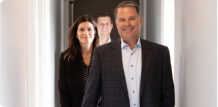/
Admin
Two months ago I bought a bulldozer-yellow Jeep Wrangler, replacing my eight year old black Audi A6. While the A6 had been a wonderful car, I was ready for something new and a Jeep fit the bill. The Jeep is large enough that I can drive my family around and while the gas mileage isn’t ideal, my daily commute to work is far less than it was when I purchased the Audi. (View a printable version of this Economic Update:
Driving with the Doors Off). Owning a Jeep is a unique experience. It’s like owning a Tonka truck for adults. You can take the whole top off, half of the top off, two doors off or all four. If you’re really crazy, you can even fold the front windshield down and feel the wind in your face, motorcycle style. In addition to all the options for dressing up or down your Jeep, owners of Jeeps, I’ve quickly discovered, are a really close bunch, giving each other a wave or a peace sign as we pass each other by. I’m now part of a strong subculture that I didn’t know even existed three months ago. My kids love the new Jeep, but my wife Lisa isn’t crazy about it. When the top is down, it makes her hair fly all over the place and she really has to step up to get in the car. Since she didn’t like my suggestion that she get a buzz cut, we’ve settled the issue by keeping the windows up while she is in the car and a few extra hairbands available around my stick shift. A few weeks ago, I took all the doors off. Scared to death by the thought that she might fall out while the car was moving, Lisa wouldn’t ride in it. It even took some hard work convincing her that Johnny, my youngest, would be okay, but she finally acquiesced. Driving with the doors off was a lot of fun, but certainly a different feeling than I was used to experiencing. The stock market over the last two months and perhaps even last three summers has been a lot like that, different, but ultimately rewarding. Despite the setbacks that each summer of the past three years has brought, we’ve eventually clawed our way out of the holes we had dug for ourselves, eventually moving on to higher highs. As 2012 comes to a close and 2013 dawns, I wouldn’t be surprised if we experienced the very same outcome. A couple of months ago, we published our last
Economic Update, in which we discussed the May employment report. At that time, total non-farm payroll additions, while positive, came in a much worse than expected 77K. Following several months of improving data, expectations had risen to 150K in anticipated new jobs, so the release was not only a disappointment, but also in our opinion, potentially game changing for how future releases might be interpreted. To us, employment gains had been a major reason for the stock market’s steady recovery from last year’s lows and why European troubles, though not gone away, no longer were given as much press. The stock market has made surprising progress since the May data was released, but the nature of the gains has been anything but typical. Defensive issues have driven the indexes higher, with high yielding telecom and utility stocks leading the way. Health care stocks, in spite of the Supreme Court’s decision, have suddenly come to life, particularly biotech and pharmaceutical stocks. Wal-Mart’s shares, which have often behaved in a countercyclical fashion, have broken substantially above price levels that they have resisted for over ten years, even in the face of bribery scandals in Mexico. While it has been great to see the S&P 500 make progress over its June lows and the release of the disappointing earnings report, I would call the rally defensive in nature at best. A search for yield in areas outside of an overpriced and risky bond market has likely contributed to the gains, an environment where conservative strategies have acted in the most price aggressive fashion. In addition to the uncharacteristic rally, the volatility of the markets has picked up, with the S&P 500 making as many as seven 4-5% moves in both directions. Earnings results, while generally strong on a year over year basis, have not been kind to investors during the third quarter summer months. Both Starbucks and Chipotle have been hammered not so much for the results that they reported, but because both said they saw a noticeable decline in customer visits during the months of June and July. At the same time, the housing sector has displayed considerable strength, with contacts in the industry I know saying that they’ve not yet talked to a single insider that didn’t think the environment was improving. While I know that the housing market has been in the doldrums for years, it is still a tad perplexing to believe that people are much more willing to shell out $250k on a new home all of a sudden, while at the same time fretting over the price of an $8 burrito or $4 cup of coffee. It’s just plain weird, but what’s new. I suppose one could say that this summer is shaping up just like the last two; significant weakness followed, hopefully, by a fall rebound. As long as housing stays strong, I think that will likely prove to be the case this time around. On Friday, the non-farm payroll numbers for the month of July were released, and as opposed to falling short of expectations like those of May, were much better than feared. The stock market responded to the news with a show of strength, with the S&P, NASDAQ and Russell 2000 all gaining 2-3%. Job gains for July came in at a positive 163K compared to expectations of only 100k. The release was powerful enough to make one wonder if it could set the markets up for a tone change, just as the May release did two months ago. Judging by the market’s response, one might say yes, but as with many moves in the markets over the last two months, volumes have hardly been convincing. Volatility is always in search of a story line and Friday’s move was no exception. The good news is that job gains seem to be moving back in the right direction, which will hopefully mark a return of glass half full investors. The Fed declined to add stimulus to the market at this month’s meeting, a move that we generally agreed with given subdued inflation and nominal job gains. While Europe still needs significant help, the United States appears to be stumbling along a slow path of growth. Clearly, 1-2% growth is scary for a nation that has typically enjoyed growth during recoveries of as much as 5-6%. One could say the same thing about China; 6-7% economic growth is scary if you’ve been used to ten. Like driving your Jeep with the doors off, you see things that you didn’t used to see before, even though the road beneath you has always been there. If we are at a point in the economy where the Fed’s assistance is no longer warranted, we just might return to a period where the risk on, risk off mentality of the markets for the last three years begins to fade, ushering in a healthier environment where corporate fundamentals like earnings and dividends gain influence. As long as our job gains are positive, I think investors will be willing to look beyond issues in overseas economies and be willing to reconsider the notion that any and all risks on a global scale are everywhere and always a threat to our own economy. While the hunger for conservative, dividend paying stocks makes sense in the recent environment, I suspect the participation of the markets will broaden out as the United States’ economic recovery appears intact. Slow growth for as far as the eyes can see remains extremely likely for the domestic economy, but with cheap natural gas, a resurgence in American manufacturing, and rising wage pressures in developing economies, we will likely remain the best game in town. In closing, this summer hasn’t been much fun, but neither were the last two. The looming fiscal cliff remains a significant issue for the markets, as will the election this fall. At the same time, our stock market is one of only a handful showing positive gains this year. Through July, the S&P 500 was up a solid 11%, better results than it has seen for the last ten years. I would also point out that since that dreaded day one year ago when Standard & Poor’s downgraded our nation’s debt from AAA status, the S&P 500 has rallied 18.6% including dividends. At least for the past few years, the overall message has been reassuring. Periods of rising uncertainty in the markets often provide great opportunities for investors, but only if you’re willing to look farther down the road, even when it feels like your doors just fell off. Hang in there and have some fun! Kindest Regards, Doug MacKay, CEO & CIO Bill Hoover, President



